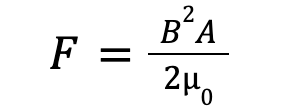Course Implementation
Course Implementation
Magnetic Actuation
Students will be using two equations from electricity and magnetism during the course of this project. One is to calculate the flux density produced by their electromagnets, and the other to calculate the force generated by a given flux density. The first equation is derived from Ampere’s Law when adapted to a solenoid with the addition of the relative permeability of the solenoid’s core. This material property (relative permeability) of the core will amplify the flux density of the electromagnet. The second equation is a modified form of the magnetic energy equation, and with it, students will be able to calculate the pulling force their electromagnet can produce. It should be noted that because the flux density produced by electromagnets (and magnets in general) follows the inverse square law, if the electromagnet doesn’t reach the theoretical limit of 2T (because of the core being used) student’s designs may be severely limited.
Modified Ampere’s Law:

B=flux density (T), μ=relative permeability of the core (unitless), 0=magnetic constant (H/M), I= the current supplied through the coils (A), l=the length of the core of the electromagnet (m), and N= number of turns of wire (unitless)
Modified Energy Equation:

F=force (N), B=flux density(T), A=cross-sectional area of electromagnet (m2), 0=magnetic constant (H/m)
The project addresses the abstract concepts of E&M by having students tinker with their own electromagnet design. By giving students a hands-on experience of the ways these equations work (seeing their robot dance by the end of it), they should come away with a much stronger sense of how these laws and equations work (and how applicable they are).